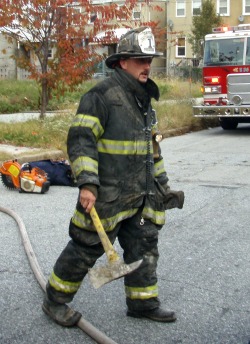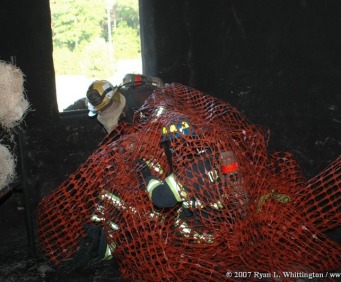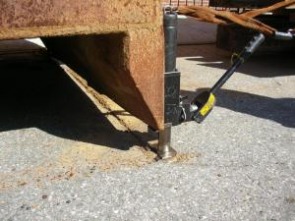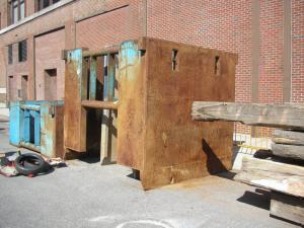The Innovations section of this page brings you new methods, ideas, inventions and street-wise techniques for the fireground. Like most great ideas, their brilliance is in their simplicity. These innovations have been contributed by your Brother Firefighters to benefit you and hopefully inspire you to create common-sense solutions to make you more efficient and safe on the fireground. Whether a fresh, new idea or simply an old method that has been modified for today's fire service, we hope you pick up a few new ideas for your tactical toolbox.
Anyone who would like to submit an Innovation - please send it to [email protected].
What's in your pockets, Capt. Payne? |
Captain James Payne of Baltimore City FD Rescue Co. 1 contributed the training link below to share with you, his brother firefighters. For those of us who know and love Brother Jimmy, his passion for the fire service and training is only equaled by his mission to live life to the fullest and have fun. With this in mind, I was scared when I first read the title of this article attached to my email. Instead of a "pull-my-finger" type attachment, I found a quick article that made me think about how I operate as a Firefighter. Brother Jimmy's article encourages you to explore the "Why" behind what YOU carry in your turn out gear. When I reflect on what I carry in my turnout gear now and how it has evolved since first joining the fire service, Captain Payne's point in his article becomes clear...there is no right or wrong answer as long as you know the "Why" behind what you are carrying.
When I first joined the Fire Service, I was told to keep my dead flashlight batteries in my pockets. I asked "Why, there dead, right?" The answer was "Before you go in, you throw them at the windows to break 'em and let the smoke out." Fortunately, this misguided attempt at applying ventilation theory was "re-directed" by my Captain who said "You can't turn a window into a door with that bull@#&%!!!" as he threw my dead Duracells in the trash. From that point on, good and bad experiences of mine and others gradually shaped the choice of tools that I carry today.
Please do yourself a favor - read Brother Jimmy's article and do a self-check of "Why" yo do what you do. As always, thanks to Captain James Payne for helping to better Firefighter safety and survival through training!
When I first joined the Fire Service, I was told to keep my dead flashlight batteries in my pockets. I asked "Why, there dead, right?" The answer was "Before you go in, you throw them at the windows to break 'em and let the smoke out." Fortunately, this misguided attempt at applying ventilation theory was "re-directed" by my Captain who said "You can't turn a window into a door with that bull@#&%!!!" as he threw my dead Duracells in the trash. From that point on, good and bad experiences of mine and others gradually shaped the choice of tools that I carry today.
Please do yourself a favor - read Brother Jimmy's article and do a self-check of "Why" yo do what you do. As always, thanks to Captain James Payne for helping to better Firefighter safety and survival through training!
SCBA Survival School...Are Your Firefighters Prepared?
SUMMARY
Self-Contained Breathing Apparatus (SCBA) is the lifeline of the firefighter. Basic SCBA training provides rudimentary skills that firefighters must build upon. Unfortunately, many firefighters and training programs neglect to advance SCBA skills to adequate levels. When the fire doesn’t go “by the book”, knowing the SCBA Continuum of Survival can make all the difference.
ABSTRACT
A firefighter dies in the line of duty while fighting a structure fire. The firefighter wasn’t injured, pinned or otherwise incapacitated. The investigation reveals that the firefighter’s mask was removed, but the regulator was functional and there was air remaining in the tank. The Firefighter Fatality Report reads, “Cause of death: Asphyxiation - Smoke inhalation, soot present in airway.”
Firefighters, the victim’s family, and investigators find this loss of life incomprehensible. How can someone die of asphyxiation when they still have air? What happened? It just doesn’t make sense! Over the past two years, approximately a dozen Firefighter Fatality Reports have read in an eerily similar way. Although we will never know exactly what happened, it begs the question, “What occurred that these firefighters ran out of options?” This question became the unintentional, yet repetitive topic of campfire discussions between me and two close friends/brother firefighters. Each one of us had individual experiences over the years where we felt our training had let us down or left us unprepared. These stories and solutions, shared over a few frosty beverages, became the basis for the case studies reviewed within the SCBA Survival School program.
Following a “near-miss” that I experienced in 1999, I had the opportunity to develop my department’s SCBA training program. This program progressively evolved into the SCBA Survival School that has been part of my department’s annual training curriculum since 2003. My experience placed in vivid relief my insufficient preparation to handle SCBA emergencies. I experienced a complete regulator failure while operating inside a commercial garage fire. Five years prior to this incident, I had graduated from my State’s Breathing Apparatus Specialist School (Smoke Divers). The invaluable lessons that this training provided me contributed to my survival of the incident. Fortunately for me, “Plan A” worked and I escaped with minor injuries. But what if I had to go to “Plan B”? I didn’t have a “Plan B”. I shared this experience with my aforementioned brothers some years later. They both had recently been intimately involved in similar incidents that resulted in LODD of firefighters in each of their departments. The conversation evolved to training solutions, being prepared, and mastering your trade.
In the United States Marine Corps, a Marine must master his trade as a rifleman. The rifle is the most basic, yet most important tool of his trade – not unlike the SCBA is to a Firefighter. A Marine must fully understand the capabilities and limitations of his rifle and be intimately familiar with its operation. Furthermore, a Marine must be able to improvise, adapt, and overcome should his rifle not perform as it would “out of the box” - not unlike a Firefighter with his SCBA. The USMC believes so much in this concept that their recruits must learn and abide by the Rifleman’s Creed. A portion of it reads: “This is my rifle, there are many like it but this one is mine. My rifle is my best friend, it is my life. I must master it as I must master my life. Without me, my rifle is useless. Without my rifle, I am useless…” A Firefighter need only replace the word “rifle” with SCBA…you get the point. The reader might ask, “So what happens when the Marine’s rifle doesn’t operate properly? Then What? The answer: Whatever you need to do to survive. The same mindset should apply to a Firefighter who encounters difficulty with his/her SCBA. For example, if a rifle jams, there is a method to clear it - we teach methods to quickly evaluate and compensate for regulator or mask failure. Should the rifle fail, there is a possible continuum for the Marine to survive despite the circumstances. Bayonets, close quarters battle, hand-to-hand combat progress from technical to the most basic elements of survival. Should the regulator fail, there are progressive methods and survival techniques to keep the Firefighter alive until he/she can get out of the structure or be rescued. The point is KEEP FIGHTING. Many Firefighters are unaware of the survival options available to KEEP THEM ALIVE!
The SCBA Survival School encompasses a variety of principles and practices for use by everyday Firefighters. These methods are equally applicable to all firefighters – rural and urban, career and volunteer. Fire does not discriminate. The SCBA Continuum of Survival illustrates the training needs of the SCBA firefighter and provides one more way that we can assure that EVERYONE GOES HOME!
Self-Contained Breathing Apparatus (SCBA) is the lifeline of the firefighter. Basic SCBA training provides rudimentary skills that firefighters must build upon. Unfortunately, many firefighters and training programs neglect to advance SCBA skills to adequate levels. When the fire doesn’t go “by the book”, knowing the SCBA Continuum of Survival can make all the difference.
ABSTRACT
A firefighter dies in the line of duty while fighting a structure fire. The firefighter wasn’t injured, pinned or otherwise incapacitated. The investigation reveals that the firefighter’s mask was removed, but the regulator was functional and there was air remaining in the tank. The Firefighter Fatality Report reads, “Cause of death: Asphyxiation - Smoke inhalation, soot present in airway.”
Firefighters, the victim’s family, and investigators find this loss of life incomprehensible. How can someone die of asphyxiation when they still have air? What happened? It just doesn’t make sense! Over the past two years, approximately a dozen Firefighter Fatality Reports have read in an eerily similar way. Although we will never know exactly what happened, it begs the question, “What occurred that these firefighters ran out of options?” This question became the unintentional, yet repetitive topic of campfire discussions between me and two close friends/brother firefighters. Each one of us had individual experiences over the years where we felt our training had let us down or left us unprepared. These stories and solutions, shared over a few frosty beverages, became the basis for the case studies reviewed within the SCBA Survival School program.
Following a “near-miss” that I experienced in 1999, I had the opportunity to develop my department’s SCBA training program. This program progressively evolved into the SCBA Survival School that has been part of my department’s annual training curriculum since 2003. My experience placed in vivid relief my insufficient preparation to handle SCBA emergencies. I experienced a complete regulator failure while operating inside a commercial garage fire. Five years prior to this incident, I had graduated from my State’s Breathing Apparatus Specialist School (Smoke Divers). The invaluable lessons that this training provided me contributed to my survival of the incident. Fortunately for me, “Plan A” worked and I escaped with minor injuries. But what if I had to go to “Plan B”? I didn’t have a “Plan B”. I shared this experience with my aforementioned brothers some years later. They both had recently been intimately involved in similar incidents that resulted in LODD of firefighters in each of their departments. The conversation evolved to training solutions, being prepared, and mastering your trade.
In the United States Marine Corps, a Marine must master his trade as a rifleman. The rifle is the most basic, yet most important tool of his trade – not unlike the SCBA is to a Firefighter. A Marine must fully understand the capabilities and limitations of his rifle and be intimately familiar with its operation. Furthermore, a Marine must be able to improvise, adapt, and overcome should his rifle not perform as it would “out of the box” - not unlike a Firefighter with his SCBA. The USMC believes so much in this concept that their recruits must learn and abide by the Rifleman’s Creed. A portion of it reads: “This is my rifle, there are many like it but this one is mine. My rifle is my best friend, it is my life. I must master it as I must master my life. Without me, my rifle is useless. Without my rifle, I am useless…” A Firefighter need only replace the word “rifle” with SCBA…you get the point. The reader might ask, “So what happens when the Marine’s rifle doesn’t operate properly? Then What? The answer: Whatever you need to do to survive. The same mindset should apply to a Firefighter who encounters difficulty with his/her SCBA. For example, if a rifle jams, there is a method to clear it - we teach methods to quickly evaluate and compensate for regulator or mask failure. Should the rifle fail, there is a possible continuum for the Marine to survive despite the circumstances. Bayonets, close quarters battle, hand-to-hand combat progress from technical to the most basic elements of survival. Should the regulator fail, there are progressive methods and survival techniques to keep the Firefighter alive until he/she can get out of the structure or be rescued. The point is KEEP FIGHTING. Many Firefighters are unaware of the survival options available to KEEP THEM ALIVE!
The SCBA Survival School encompasses a variety of principles and practices for use by everyday Firefighters. These methods are equally applicable to all firefighters – rural and urban, career and volunteer. Fire does not discriminate. The SCBA Continuum of Survival illustrates the training needs of the SCBA firefighter and provides one more way that we can assure that EVERYONE GOES HOME!
The "J" Tool
February 13, 2010 – 22:46 The “J-TOOL” is a home-made solution to a common forcible entry situation. This tool is used to actuate panic hardware from the outside of the structure. For the frugal, budget-starved firefighters and instructors amongst us (A.K.A. Dumpster Divers ) the raw material for the J-Tool is readily available. Simply, it is fabricated from the wire antennae from a junk vehicle. With a bench vise and “encouragement” from a hammer, the wire antennae is formed into opposing “J” patterns to specific dimensions. STBT’s brothers & sisters from Wichita Metro Fire provided this video that illustrates how to use this low-budget wonder! Special thanks to FF Chad Cox for producing the video. For more information on the J-Tool, call or email STBT.
In true truckie fashion, FF Sam Hittle took this technique to a new level and created some additional methods and alternate tool uses for overcoming panic hardware on steel doors without windows for reference. His contributions to Fire Engineering (articles, pictures, and videos) are PHENOMENAL – do yourself a favor and check them out!
In true truckie fashion, FF Sam Hittle took this technique to a new level and created some additional methods and alternate tool uses for overcoming panic hardware on steel doors without windows for reference. His contributions to Fire Engineering (articles, pictures, and videos) are PHENOMENAL – do yourself a favor and check them out!
Thinking Outside The Box

TECH TIP: HYDRA RAM
The Hydra Ram is a tool commonly carried by Engines, Trucks, Rescues, and Paramedic Units. Hydra Rams are used mainly for quickly forcing heavier residential and commercial doors. This tool is very versatile, with 4 inches of spread and 10,000 lbs of spreading force and can also be used in a variety of applications. In this example, it is necessary to lift a heavy object but there is no purchase point (too tight for air bags or a bottle-jack) use a Hydra-Ram to create a purchase or lift the object.
The Hydra Ram is a tool commonly carried by Engines, Trucks, Rescues, and Paramedic Units. Hydra Rams are used mainly for quickly forcing heavier residential and commercial doors. This tool is very versatile, with 4 inches of spread and 10,000 lbs of spreading force and can also be used in a variety of applications. In this example, it is necessary to lift a heavy object but there is no purchase point (too tight for air bags or a bottle-jack) use a Hydra-Ram to create a purchase or lift the object.
Courtesy FDNY Squad 18 REMEMBER – ALWAYS CRIB AS YOU GO!!!
Ladder Spikes
|
Coming soon to FDIC 2012!
Ladder Spikes - Another innovation from our brothers from the Mid-West! Make sure to check out Sam Hittle's presentation on window work, size-up, and tactics (featuring the innovation - Ladder Spikes). If you're attending FDIC 2012 - it is a must see! Be there - 10:30 on Thursday, April 19th |




